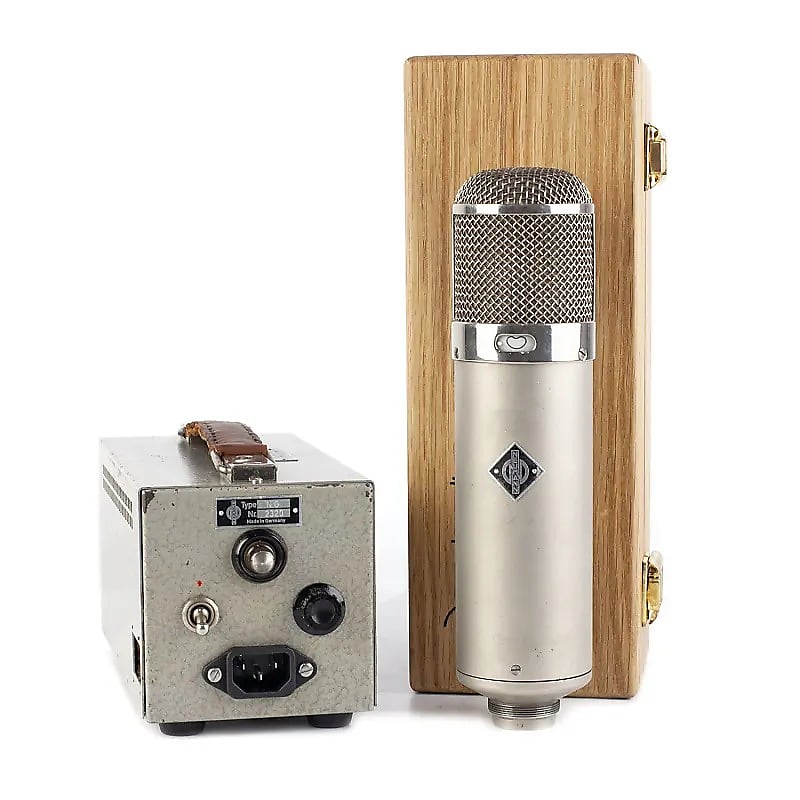Vintage Neumann U 47s and Their Modern Counterparts
Vintage Neumann U 47s are some of the most revered microphones in history. Although just about 5,600 were made, from 1949 to the early '60s, the original runs of the large diaphragm condenser became fixtures in mid-century recording studios. As the popular music industry swelled, U 47s became go-to vocal and instrument mics, used by names like Ray Charles, Frank Sinatra, Ella Fitzgerald, Nat "King" Cole, The Beatles, and countless others. Today, you can still find them in professional studios' working mic lockers and in collectors' vaults.
Even more common are microphones inspired by the U 47, mics across price points that aim to embody or at least get in the ballpark of the 47's legendary sound. These include boutique recreations that try to be as faithful as possible to the original circuitry. While expensive, these near-replicas are reasonably priced for professionals, built to last, and don't come with the headaches or investment-pricing of a vintage original.
There are also a number of more budget-friendly alternatives, which use widely available components or cheaper labor in order to cut costs. Tube mic circuitry is always going to come with some expense, no matter how you slice it, but these mics are a fraction of the price of original 47s and a great deal cheaper than the more-exacting replicas.
Below, you'll find a wide variety of 47s of 47-like mics available on Reverb. But first, let's talk about why people love the Neumann U 47 so much in the first place.
What's So Special About a Vintage U 47?
If you want to know the full ins-and-outs of classic 47s, you can read Reverb's "Vintage Neumann (Telefunken) U 47 Buyer's Guide." But the basic gist is: When the U 47 was first released, it offered more clarity, nuance, and character in a microphone than just about anyone had ever heard. This was due to a combination of elements, but three main components were critically important:
The M7 or K47 capsule - The earliest 47s had M7 capsules made with PVC, which dries out and cracks with time. Neumann created the more resilient K47 capsule and used it in subsequent production runs. Modern M7- and K47-style capsules are still in production and can be found in a lot of new 47-style mics.
The VF14M tube - The 47's tube impedance converter is the most important puzzle piece to the mic's magic sound. Unfortunately, the tube—created out of steel by Telefunken in limited quantities—has been out of production for over 60 years. Modern 47-style mics use a variety of substitutes instead.
The BV08 transformer - The BV08 output transformer (also written as BV8) is an intricate design created in-house at Neumann. Some builders recreate the transformer, while many others swap it out for easier-to-source transformers.
When combined in original U 47s, these elements offer a startlingly crisp and detailed sound—with full lows and sultry highs—in either cardioid or omnidirectional pickup patterns.
Neumann U 47 vs. U 47 FET and U 48
In 1969, Neumann began making the U 47 FET, which used solid-state transistors in place of the VF14M tube. While it was promoted as an equivalent to the original, they sound quite different and are often used for different purposes. While the tube U 47 and its clones are the first-choice for vocalists, engineers often use the U 47 FET for kick drums, amplifiers, and other loud instruments, since the solid-state circuitry can handle higher sound pressure levels than the tube mic.
One other mic you'll see mentioned alongside the U 47 is the U 48. Built at the same time as the original U 47s, the U 48 is basically the same mic, but it can record in a figure 8 bidirectional pattern or cardioid, instead of the 47's omnidirectional or cardioid pickup patterns.
Is Telefunken the Same as Neumann?
Neumann and Telefunken were and are different companies. However, their stories are intertwined. As stated above, the tube that lies at the heart of the U 47's design was built by Telefunken. Telefunken was also the distributor for Neumann mics for some of the original production years of the U 47 (1949–'58), which is where much of the confusion lies.
During that time period, Telefunken placed its own logo on the body of Neumann mics it distributed. So many people then would refer to the mics as "Telefunkens." After the distribution deal ended, some Telefunken-marked Neumanns were rebadged with Neumann logos, but you can still find Telefunken-badged Neumann U 47s on the vintage market. However, the original U 47s were built by Neumann alone.
That said, the Telefunken brand was revived in the United States in 2001. And today's Telefunken does create several of its own 47-style mics: the Telefunken Elektroakustik U47, TF47, and others.
Modern U 47 Clones and Counterparts
Bock Audio, Lawson, Wagner, Wunder, Flea Microphones—these are just some of the companies creating 47-style mics today. Some are only available new through custom orders, but will show up as used listings on Reverb. All of them and more are worth checking out if you're in the market for a nice microphone. Below, you can find a wide variety of 47-style mics—across price points—all currently for sale on Reverb

.](https://res.cloudinary.com/reverb-cms/image/upload/curation%2Ftyghih6ogsunuq0qmutu)